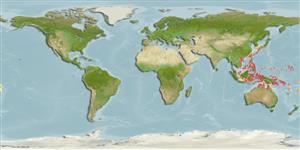Klassifizierung / Names
Namen | Synonyme | Catalog of Fishes(Gattung, Arten) | ITIS | CoL | WoRMS | Cloffa
>
Gobiiformes (Gobies) >
Gobiidae (Gobies) > Gobiinae
Etymology: Trimma: Greek, trimma, -atos = something crushed (Ref. 45335); hayashii: Named for Mr. Masayoshi Hayashi.
Eponymy: Dr Masayoshi Hayashi is Curator, Yokosuka City Museum. [...] (Ref. 128868), visit book page.
More on authors: Hagiwara & Winterbottom.
Environment: milieu / climate zone / depth range / distribution range
Ökologie
seewasser riff-verbunden; tiefenbereich 0 - 26 m (Ref. 58123). Subtropical
Western Pacific: Japan to the Solomons.
Size / Gewicht / Alter
Maturity: Lm ? range ? - ? cm
Max length : 2.3 cm SL Männchen/unbestimmt; (Ref. 58123)
Kurzbeschreibung
Bestimmungsschlüssel | Morphologie | Morphometrie
Rückenflossenstacheln (insgesamt) : 7; Rückenflossenweichstrahlen (insgesamt) : 8 - 9; Afterflossenstacheln: 1; Afterflossenweichstrahlen: 7 - 8. This species is characterized by the following: dorsal spine a little elongated or not; presence of a basal membrane between the pelvic fins; absence of predorsal scales; an interorbital but no postorbital trench; absence of cheek and opercular scales; fifth pelvic fin ray branched sequentially once or twice and, uniquely among known species of Trimma, has a bilateral, pupil-sized black spot on the branchiostegal membrane; live individuals with red spots, a little smaller than the pupil diameter on the head and nape, the posterior half of body has 3 yellow stripes separated by 2 grey stripes, and the black spots on the branchiostegal membranes are ocellated with white or blue (Ref. 58123).
Lives under corals in embayments, which are sometimes covered by siltation. Also found in caves and crevices of sheltered reefs (Ref. 90102). It often positions itself upside-down on the roof of the recess (Ref. 58123).
Life cycle and mating behavior
Geschlechtsreife | Fortpflanzung | Ablaichen | Eier | Fecundity | Larven
Hagiwara, K. and R. Winterbottom, 2007. Two new species of Trimma (Gobiidae) from the Western Pacific. Bull. Natl. Mus. Nat. Sci., Ser. A, Suppl. 1:163-174. (Ref. 58123)
IUCN Rote Liste Status (Ref. 130435: Version 2024-2)
Bedrohung für Menschen
Harmless
Nutzung durch Menschen
Fischereien: nicht kommerziell
Tools
Zusatzinformationen
Download XML
Internet Quellen
Estimates based on models
Preferred temperature (Ref.
123201): 25.3 - 29.3, mean 28.7 °C (based on 1246 cells).
Phylogenetic diversity index (Ref.
82804): PD
50 = 0.5000 [Uniqueness, from 0.5 = low to 2.0 = high].
Bayesian length-weight: a=0.01023 (0.00477 - 0.02194), b=3.01 (2.83 - 3.19), in cm total length, based on LWR estimates for this (Sub)family-body shape (Ref.
93245).
Widerstandsfähigkeit (Ref.
120179): hoch, Verdopplung der Population dauert weniger als 15 Monate. (Preliminary K or Fecundity.).
Fishing Vulnerability (Ref.
59153): Low vulnerability (10 of 100).
Nutrients (Ref.
124155): Calcium = 258 [88, 845] mg/100g; Iron = 1.74 [0.70, 4.09] mg/100g; Protein = 18.7 [16.5, 20.7] %; Omega3 = 0.254 [0.080, 0.784] g/100g; Selenium = 14.2 [3.9, 42.1] μg/100g; VitaminA = 77.4 [13.4, 432.1] μg/100g; Zinc = 3.07 [1.55, 5.49] mg/100g (wet weight);
